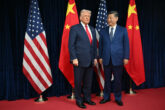December 08, 2015
Crouching Tiger: What China's Militarism Means for the World
On December 7, 2015, CNAS’s Asia-Pacific Security Program hosted a roundtable discussion on Chinese military modernization and Peter Navarro’s recent book and miniseries on the subject, works that feature interviews with dozens of foreign policy experts and practitioners. Dr. Navarro joined Dr. Toshi Yoshihara and Dr. Stefan Halper in leading a conversation on China’s recent rapid militarization, increasing assertiveness in the Asia-Pacific, growing economic prominence, and these trends’ implications for the United States and the global order.
Dr. Navarro outlined what he argued was an ominous combination of Chinese intentions, capabilities, and emerging strategies. First, China is emerging from a century of humiliation, with a “never again” mentality toward standing up for itself on the world stage. Combined with a growing interest in protecting its own economic and political sphere of influence, Dr. Navarro argued this is creating a trajectory toward destabilizing, revisionist aggression. Building defensive weapons to protect sea lanes is one, he said, while developing offensive weapons of fearsome scope and power to intimidate neighbors and rivals is entirely another.
Those new weapons make up the capabilities part of Dr. Navarro’s calculus. With its huge array of conventional and dual-use missiles, increasingly sophisticated sea mines, and rapid development in the spheres of space and cyber war, Chinese planners seem to be telegraphing a commitment to an aggressive strategy rather than a defensive one. Dr. Navarro outlined how these strategies could promote uncontrolled escalation in flashpoints throughout the region.
Dr. Navarro concluded by urging that the United States turn away from neo-isolationism and a misplaced faith in economic engagement or nuclear deterrence alone. Instead, he proposed a strategy of “comprehensive national power,” one that emphasized not only military strength but also the importance of a strong, growing economic foundation to buttress both hard and soft power. Dr. Navarro pointed to the U.S. education system, tax codes, and trade policies as in particular need of overhaul to sustain 21st century comprehensive national power.
Discussants debated how urgent or severe the threat of Chinese revisionist ambitions may be, particularly in the face of economic and demographic headwinds. Those in attendance generally agreed, however, that trends in Chinese military modernization and strategy are indeed worrying, as well as to what extent civilian control of military operations will persist in crisis operations.
More from CNAS
-
North Korea Reveals Troop Dispatch to Russia amid U.S.-South Korea Policy Talks
North Korea has confirmed for the first time that its troops are operating in Russia, and it is preparing to rewrite its party charter with the possibility of officially namin...
By Dr. Go Myong-Hyun
-
Chinese Maker of Bitcoin-Mining Machines Is a Security Threat, Says Expert
Bloomberg News reports that a Chinese manufacturer, Bitmain Technologies Ltd, that sells most of the world’s Bitcoin-mining machines — including 16,000 of them to a venture ba...
By David Feith
-
Indo-Pacific Security / Energy, Economics & Security
North Korea’s Provocations, Power Plays, and Shifting AlliancesTensions on the Korean Peninsula have reached a new and dangerous threshold. President Lee Jae Myung is warning of a real risk of accidental military clashes, as the situation...
By Dr. Go Myong-Hyun
-
Indo-Pacific Security / Energy, Economics & Security
How to Win the Economic War with ChinaTrump's approach to China has run aground, giving Beijing unprecedented advantage in the economic conflict....
By Edward Fishman & Julian Gewirtz



